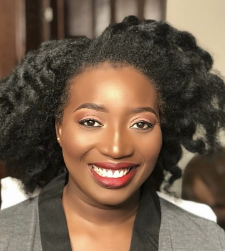Flexibility and daytime freedom are what led Oghenemine Djebah to choose Birkbeck to study an MA/LLM Criminal Law and Criminal Justice. In this blog, the Nigerian student shares his journey so far with us.
After obtaining an LLB from the Delta State University, Oghenemine Djebah enrolled at the Nigerian Law School, where he graduated with a Bachelor of Laws and was subsequently called to the Nigerian bar. Since then, he has been in active legal practice in Nigeria.
He worked for two notable law firms (Rotimi Jacobs & Co. and Zatts Law Chambers) and volunteered to give free legal services through a registered NGO (Fundamental Rights Enforcement Enlightenment and Defense).
During a 2019 visit to London, Oghenemine fell for the culture and diversity of the city. So, when his desire to gain more in-depth knowledge of the workings of the law inspired him to pursue an LLM he naturally focused his search on universities in the capital. “I started searching for an institution that would be flexible enough to let me work or volunteer while I studied. I found out about Birkbeck on the internet and the evening lectures tallied with the type of institution I was looking for, so I applied and was given admission into the School of Law.”
As the pandemic took hold around the world, Oghenemine considered deferring his admission by a year. “Because of the financial challenges caused by COVID-19 it was quite a challenge getting the initial deposit in time. The management of Birkbeck recognised this and made the concession of reducing the initial deposit by 90% for all international students, which gave me the opportunity to meet all of the requirements and enroll for the 2020 session.” In recognition of his potential Oghenemine was subsequently awarded a Birkbeck International scholarship and a School of Law Postgraduate Award.
The pandemic’s impact was not only financial as, first the Autumn, then the Spring terms were moved online. Oghenemine embraced the challenges and attended online orientation, public lectures as well as the international student’s virtual event at the beginning of the academic year. He reflected: “The international student event was really helpful for me in understanding my role as an international student, including the benefits and how to tap into them.”
Oghenemine has also been making good use of the online services available to students: “The Birkbeck Careers platform is great and enables students not only to see available jobs and apply but also to help teach them how to prepare for interviews and tailor their CVs and cover letters to meet professional standards.”
With a few months of studies under his belt, the Nigerian student assesses his time learning online. “This is actually my first time doing any course via virtual learning. It is quite challenging because I do not get to meet with other students and make good connections which is also part of the university life. However, the lectures have been going great, better than I expected because we are provided with pre-recorded videos for each lecture. The COVID-19 pandemic has made everything different, from living, to studying. Not being able to meet physically and always being indoors has made this period a bit difficult. I look forward to having the opportunity to meet physically with my fellow students and lecturers before graduating from Birkbeck.”
More than anything the Law student sees and embraces the positives studying in London and at Birkbeck can bring: “London is well known for welcoming international students globally, including from Nigeria. Being a student in London enables you to be a part of a well-integrated international and diverse community. London is a city with a lot of opportunities for everyone beyond academic programs. I advise all Nigerians who wish to study internationally to study in London and join a diverse community and tap into the available opportunities.”
More information:




